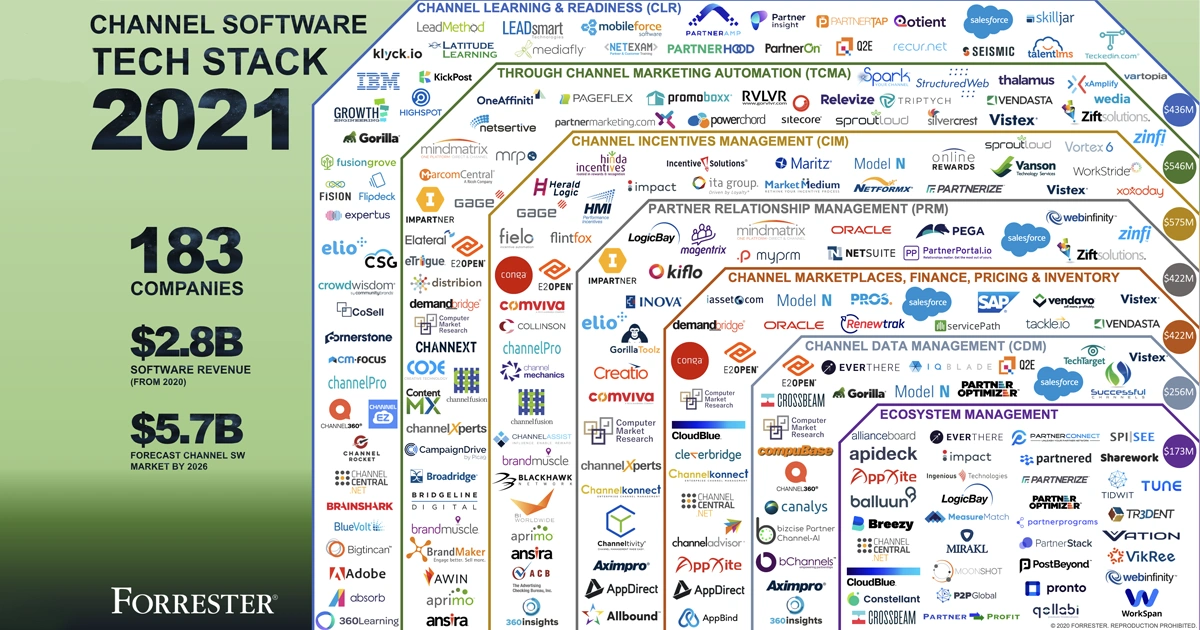
Vistex Makes Forrester’s 2021 Channel Software Tech Stack
Vistex named in 4 categories
Happy New Year Tech Stack! The 2021 Channel Software Tech Stack has arrived. Each January, Jay McBain, Forrester’s Principal Analyst, Channel Partnerships & Alliances, plows through the morass of channel software companies and selects the cream of the crop for inclusion in his eye-boggling infographic. The tech stack is intended to be a quick-reference guide for enterprise-level companies seeking solutions to automate and manage their business.
According to McBain, The channel software stack comprises a group of technologies that help companies develop, design, and execute plans to find, recruit, onboard, develop, enable, incent, co-sell with, manage, measure, and report on partners.
Total 2020 revenue for the companies included in his list was $2.8 billion. Despite the ravages of COVID-19 on most industries, that’s an 8.9% increase over 2019. McBain estimates that this market will explode to $5.7 billion by 2026.
The 2021 Tech Stack features software solutions in the following categories:
- Channel Learning & Readiness ($436M in 2020 revenue)
- Through Channel Marketing Automation ($546M)
- Channel Incentives Management ($575M)
- Partner Relationship Management ($422M)
- Channel Marketplaces, Finance, Pricing & Inventory ($422M)
- Channel Data Management ($256M)
- Ecosystem Management ($173M)
Vistex is featured in 4 categories:
- Through Channel Marketing Automation, which
enables partners to engage their customers with a consistent vendor brand experience to create awareness and generate demand.
- Channel Incentives Management, which
manages design, allocation, tracking, and distribution of financial incentives to the partner ecosystem, including market development funds (MDFs), sales performance incentive funds (SPIFs), co-ops, bonuses, rebates, price protection, channel sales compensation, and loyalty programs.
- Channel Marketplaces, Finance, Pricing & Inventory, which
manages indirect-sales-related revenue and costs, determines the correct value of transactions, automates key financial reporting processes, and prevents errors in payment, commission, and rebates.
- Channel Data Management, which
collects, cleanses, and aggregates transactional point-of-sale and inventory data from partners and distributors in a trusted single data asset that enables business and actionable intelligence.
Ecosystems as the key to disruption
According to McBain, The future of channels, alliances, and ecosystems will be anchored on automation, flexibility, scalability, and self-service.
He emphasizes the disruptive effect that ecosystems will have on the future economy and cites a recent study from Accenture that highlights their impending rise to dominance. 76% of business leaders surveyed agree that current business models will be unrecognizable in the next 5 years, and ecosystems will be the source of this disruption. As defined by Accenture, an ecosystem is a network of cross-industry players who work together to define, build and execute market-creating customer and consumer solutions.
One example is healthcare providers who partner with rideshare companies to make sure more patients are able to keep their appointments.
The beauty and efficiency of the ecosystem is that no single player must own or operate all components of the solution. And the value generated is greater than the sum of the parts.
Kick those spreadsheets to the curb
McBain concludes, The future of channels, alliances, and ecosystems will be anchored on automation, flexibility, scalability, and self-service.
With high volumes of data incoming at a ferocious velocity, the partner landscape has been reimagined. Spreadsheets and highly manual processes are woefully insufficient to manage the intricacies of a successful partner program. Says McBain: The effective use of technology tools is no longer optional — ecosystems don’t run on spreadsheets!
Check out the 2021 Channel Software Tech Stack for yourself.
Get the latest news, updates, and exclusive insights from Vistex delivered straight to your inbox. Don’t miss out—opt in now and be the first to know!
